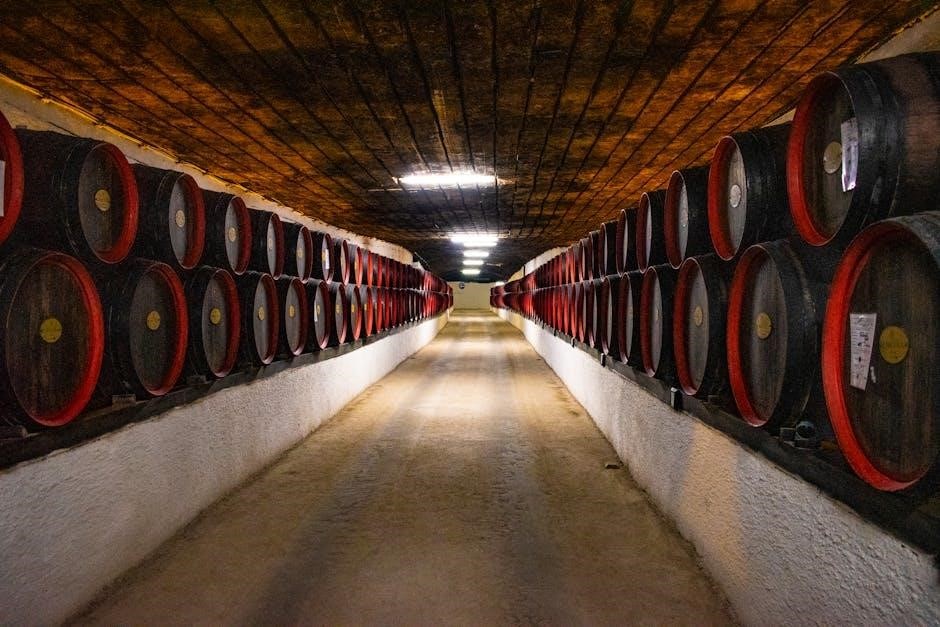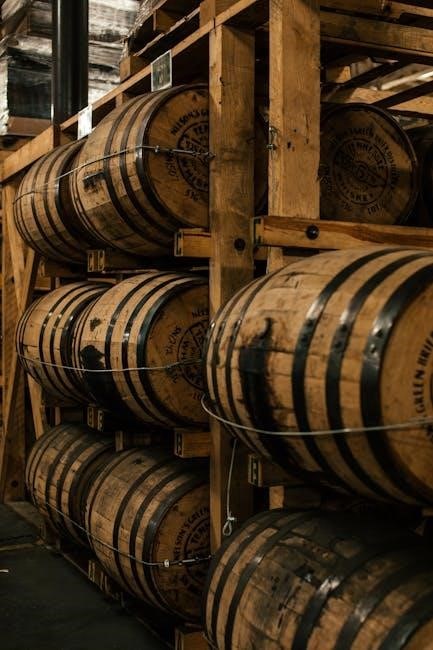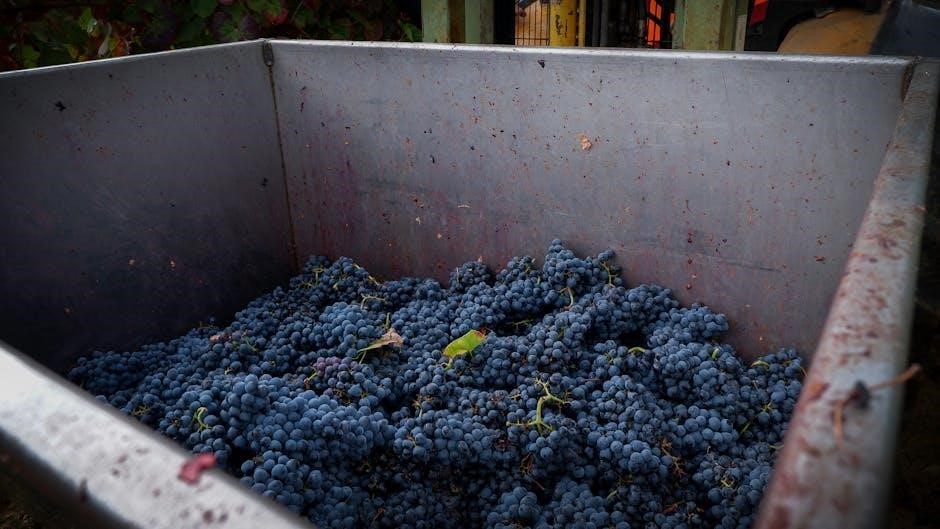Fermentation is a transformative process that unlocks flavors, textures, and aromas, connecting culinary traditions with innovation. This ancient technique, perfected in Noma’s kitchen, revolutionizes modern cuisine.
1.1 The Science Behind Fermentation
Fermentation is a biochemical process driven by microorganisms like bacteria, yeast, and mold. These microbes feed on sugars, producing acids, alcohol, or carbon dioxide. Lacto-fermentation, for instance, relies on lactic acid bacteria to preserve food and enhance flavor. Koji, a fungus, breaks down proteins and carbohydrates into umami-rich compounds. Understanding pH levels, temperature, and oxygen levels is crucial for controlling fermentation. Enzymes play a key role in transforming raw ingredients into complex, aromatic compounds. This natural process not only preserves food but also creates unique, depthful flavors, as seen in Noma’s innovative use of fermentation to elevate culinary creations.
1.2 Historical Significance of Fermentation
Fermentation has been a cornerstone of food preservation and culinary innovation for thousands of years. Ancient civilizations relied on it to create nutritious, flavorful foods like sauerkraut, miso, and kombucha. This traditional technique allowed communities to survive by transforming perishable ingredients into enduring staples. Fermentation not only preserved food but also enriched diets with probiotics and unique flavors. Its historical roots are intertwined with cultural identity, as recipes and methods were passed down through generations. Today, chefs like René Redzepi are revitalizing these ancient practices, blending tradition with modern creativity. Fermentation’s enduring relevance underscores its importance in both sustenance and culinary artistry, bridging past and future.
The Noma Approach to Fermentation
Noma’s innovative approach redefines fermentation, blending tradition with creativity. Their fermentation lab experiments with bold flavors, pushing boundaries and inspiring modern cuisine with groundbreaking techniques and creative flavor profiles.
2.1 René Redzepi and David Zilber’s Vision
René Redzepi and David Zilber’s vision for fermentation goes beyond traditional boundaries, seeking to unlock new dimensions of flavor and texture. Their collaborative work at Noma’s fermentation lab focuses on experimentation and innovation, blending ancient techniques with modern creativity. Redzepi, the visionary chef, and Zilber, the fermentation expert, aim to redefine fermentation’s role in contemporary cuisine. Their shared goal is to explore the endless possibilities of this process, from koji and garum to lacto-ferments, creating a foundation for bold, unique dishes. This partnership has not only elevated Noma’s culinary reputation but has also inspired a global movement in fermentation practices.
2.2 Noma’s Fermentation Lab
Noma’s Fermentation Lab is the heart of innovation, where chefs and scientists experiment with ingredients and techniques to create groundbreaking flavors. This dedicated space is where the magic happens, pushing the boundaries of traditional fermentation methods. The lab’s focus is on understanding and mastering the microbial processes that transform raw materials into unique culinary elements. From koji to garum, the team explores every aspect of fermentation, ensuring Noma remains at the forefront of gastronomic excellence. This laboratory not only drives the restaurant’s menu but also inspires a global community of chefs and home cooks to embrace fermentation’s endless possibilities.
2.3 Creative Flavor Profiles
Noma’s approach to fermentation is a gateway to inventive and complex flavor profiles that redefine modern cuisine. By experimenting with unexpected ingredients like black fruits and vegetables, the chefs craft bold, umami-rich dishes. Fermentation transforms ordinary elements into extraordinary ones, creating layers of taste that surprise and delight. From the tangy zip of lacto-fermented vegetables to the deep savory notes of garum, each flavor tells a story. These creative profiles not only enhance Noma’s menu but also inspire home cooks to explore fermentation’s potential, making it a cornerstone of contemporary culinary artistry. The result is a harmonious balance of tradition and innovation, setting new standards in gastronomy.

Essential Fermentation Techniques
Noma’s fermentation techniques include lacto-fermentation, koji fermentation, and garum-making. These methods, detailed in their guide, are key to unlocking the restaurant’s signature creative flavor profiles and culinary innovation.
3.1 Lacto-Fermentation
Lacto-fermentation is a foundational technique in Noma’s culinary arsenal, harnessing lactic acid bacteria to transform ingredients. This natural process creates bold, tangy flavors and preserves food. Noma’s guide details how to apply this method to vegetables, fruits, and even meats, emphasizing the importance of salt concentration and temperature control. By understanding the balance between bacteria and environment, home cooks can replicate Noma’s innovative recipes, such as fermented turnips or cabbage, which add depth to modern dishes. The guide also explores creative applications, pushing the boundaries of traditional lacto-fermentation to craft unique, restaurant-level results. This technique is central to Noma’s ability to coax extraordinary flavors from ordinary ingredients, making it a cornerstone of their fermentation philosophy.
3.2 Koji Fermentation
Koji fermentation, driven by the Aspergillus oryzae fungus, is a cornerstone of Noma’s innovative culinary practices. This ancient method transforms grains, legumes, and vegetables into umami-rich ingredients like miso, shoyu, and garum. Noma’s guide provides detailed insights into cultivating koji, emphasizing temperature and humidity control to ensure optimal growth. The restaurant’s fermentation lab has perfected techniques to harness koji’s enzymatic power, creating deep, savory flavors that elevate dishes. By experimenting with diverse substrates, Noma pushes the boundaries of traditional koji applications, offering modern twists while respecting its historical roots. This versatile fungus is integral to Noma’s ability to craft bold, complex flavors, making it a defining element of their fermentation-driven cuisine.
3.3 Making Garum
Garum, a traditional fermented fish sauce, is reimagined in Noma’s culinary repertoire as a versatile umami enhancer. The process involves fermenting small fish like mackerel or anchovies with salt, allowing natural enzymes to break down proteins into a deep, savory liquid; Noma’s guide details the precise balance of fish to salt and the importance of controlled fermentation temperatures to avoid overpowering flavors. This ancient technique, refined in Noma’s lab, results in a nuanced, aromatic condiment that elevates dishes without overwhelming them. Garum’s rich, velvety texture and complex flavor profile make it a cornerstone in Noma’s innovative fermentation practices, bridging tradition with modern gastronomy.

Key Ingredients in Noma’s Fermentation
Koji, black fruits, and fermented grains are central to Noma’s fermentation, offering rich, complex flavors and versatility in creating innovative culinary masterpieces.
4.1 Koji: The Miracle Mold
Koji, a type of fungus, is a cornerstone in Noma’s fermentation processes. It breaks down ingredients into umami-rich compounds, enhancing flavors in dishes like miso and shoyu. Versatile and essential, koji transforms grains, vegetables, and proteins, creating depth and complexity. Its ability to ferment at controlled temperatures makes it a key tool for Noma’s chefs, unlocking new culinary possibilities and elevating traditional recipes to modern gastronomic art. This miracle mold is celebrated for its transformative power in the kitchen, making it an indispensable ingredient in Noma’s innovative approach to fermentation.
4.2 Black Fruits and Vegetables
Black fruits and vegetables, such as black currants, elderberries, and black garlic, are prized for their deep, complex flavors and vibrant colors. Noma’s fermentation processes highlight these ingredients, creating bold, umami-rich profiles. Black produce is fermented to enhance its natural sweetness and acidity, making it a key component in sauces, dressings, and garnishes. The use of black fruits and vegetables not only adds visual appeal to dishes but also showcases the restaurant’s commitment to innovation and seasonal ingredients. These fermented creations are a testament to Noma’s dedication to exploring the full potential of nature’s bounty, transforming simple ingredients into extraordinary culinary experiences.
4.3 Fermenting Grains
Fermenting grains is a cornerstone of Noma’s culinary innovation, unlocking their full potential. Grains like barley, rye, and oats are transformed through lactic acid fermentation or koji inoculation, creating deeply umami-rich products. This process enhances their natural flavors and textures, yielding ingredients like miso, shoyu, or fermented grain porridges. Noma’s approach emphasizes the versatility of grains, using them in everything from sauces to bread. The fermentation of grains not only preserves them but also elevates their culinary value, making them a staple in modern Nordic cuisine. By experimenting with ancient techniques, Noma redefines how grains can be used in contemporary dishes, showcasing their complexity and depth.

Fermentation Recipes from Noma
Noma’s fermentation recipes offer creative twists on classics. From kombucha to miso and garum, each recipe is meticulously detailed, ensuring bold flavors and culinary innovation.
5.1 Kombucha and Other Fermented Drinks
Kombucha and other fermented drinks are highlighted in Noma’s guide as refreshing and probiotic-rich beverages. The book shares creative recipes, such as seasonal fruit-infused kombucha, showcasing how fermentation can elevate simple ingredients into vibrant drinks. Noma’s approach emphasizes experimentation, encouraging readers to explore unique flavor combinations. Detailed instructions guide home fermenters through the process, from brewing to bottling. These recipes not only offer health benefits but also introduce a new dimension of flavor to modern cuisine, aligning with Noma’s commitment to innovation and sustainability. The guide’s focus on fermented drinks underscores the versatility of fermentation beyond traditional foods.
5.2 Miso and Shoyu
Noma’s guide delves into the art of crafting miso and shoyu, traditional Japanese fermented staples. These ingredients, rich in umami, are elevated through Noma’s innovative techniques. The book provides detailed recipes for homemade miso, showcasing the importance of koji and patient fermentation. Shoyu, a fermented soybean sauce, is also explored, with methods to create depth and complexity. Noma’s approach blends tradition with creativity, offering unique flavor profiles. These fermented products not only enhance dishes but also highlight the transformative power of fermentation. With clear instructions, home cooks can master these iconic ingredients, integrating them into modern cuisine. The guide’s focus on miso and shoyu reflects Noma’s commitment to preserving and reinventing culinary traditions.
5.3 Fermented Vinegars
Fermented vinegars are a cornerstone in Noma’s culinary arsenal, offering a tangy, complex base for dressings and sauces; The guide provides simple yet impactful recipes for crafting vinegars from various ingredients like apples, grapes, and even foraged plants. Noma’s approach emphasizes patience, allowing natural fermentation to develop deep, nuanced flavors. These vinegars are not just condiments but tools for balancing and enhancing dishes. With clear instructions, home cooks can experiment with unique flavor profiles, creating everything from traditional apple cider vinegar to innovative fermented herbal infusions. This section highlights the versatility of vinegar fermentation, encouraging creativity and experimentation in the kitchen. Noma’s techniques ensure that every batch is a testament to the alchemy of fermentation.

Equipment and Tools for Fermentation
Essential tools for fermentation include glass jars, weights, and temperature control devices. These items ensure proper conditions for creating koji, miso, and garum, as detailed in Noma’s guide.
6.1 Essential Gear for Home Fermenters
For home fermentation, essential gear includes glass jars with lids, fermentation weights, and a thermometer for temperature control. These tools ensure optimal conditions for creating koji, miso, and garum. A ceramic or plastic container is ideal for lacto-fermentation, while a hygrometer can monitor humidity levels. Cheesecloth or a breathable cloth helps maintain airflow, preventing contamination. Stainless steel or silicone spoons are recommended for handling fermented products. For more advanced techniques, a dehydrator or proofing box can provide consistent temperatures. Investing in quality equipment ensures successful fermentation and longevity of your creations. These tools, as highlighted in Noma’s guide, are indispensable for achieving professional-grade results at home.
6.2 Heating and Temperature Control
Temperature control is crucial for successful fermentation, as it directly impacts microbial activity and flavor development. For home fermenters, maintaining consistent temperatures between 64°F and 75°F is ideal for most processes. A proofing box or a temperature-controlled environment, such as a thermometer-equipped water bath, can provide precise conditions. Noma’s fermentation lab relies on advanced heating systems, but home cooks can achieve similar results with simpler setups, like a draft-free pantry or a low-temperature oven. Monitoring temperature ensures that ferments develop evenly and prevents unwanted contamination. This attention to detail, as emphasized in Noma’s guide, elevates fermentation from a hobby to a precise culinary art, yielding consistent and exceptional results.
Safety and Best Practices
Fermentation requires meticulous hygiene, proper equipment, and controlled environments to ensure safety and quality. Regular monitoring of pH levels and visible signs prevents contamination and spoilage effectively.
7.1 Avoiding Contamination
Avoiding contamination is crucial for successful fermentation. Use sterilized equipment and clean work surfaces to minimize bacterial growth. Regularly monitor fermenting batches for off-flavors or mold. Proper sealing of containers prevents airborne contaminants from entering. Maintain consistent temperatures to inhibit unwanted bacteria. Sanitize utensils and storage vessels thoroughly before use. Following tested recipes and guidelines ensures a safe fermentation process. Be vigilant about visible signs of spoilage, such as mold or sliminess, and discard any compromised batches immediately. Cleanliness and attention to detail are key to achieving consistent, high-quality results in fermentation.
7.2 Storage and Maintenance
Proper storage and maintenance are vital to preserve the quality and safety of fermented products. Store ferments in airtight containers to prevent contamination and exposure to air, which can lead to mold or off-flavors. Keep containers in a cool, dark place, such as a pantry or refrigerator, to slow down fermentation. Regularly inspect stored ferments for signs of spoilage, such as mold or sliminess, and discard any compromised batches. For long-term storage, refrigerate to halt the fermentation process and maintain freshness. Cleanliness and consistent conditions ensure the longevity and flavor of your ferments. Proper storage and maintenance are essential for enjoying your creations year-round.

Fermentation in Modern Cuisine
Fermentation has revolutionized modern cuisine, offering chefs unparalleled creativity. René Redzepi and David Zilber’s innovative techniques at Noma have inspired a new wave of culinary exploration and flavor discovery.
8.1 Innovation in Fermentation
Fermentation at Noma has become a cornerstone of culinary innovation. René Redzepi and David Zilber pioneered new techniques, pushing the boundaries of traditional methods. Their work in the fermentation lab led to groundbreaking creations, such as black fruit ferments and innovative uses of koji. These advancements not only elevated Noma’s dishes but also inspired a global movement. By experimenting with unexpected ingredients and refining processes, they demonstrated how fermentation could unlock unprecedented flavor profiles. This innovation has redefined modern cuisine, proving that fermentation is not just a preservation method but a creative tool for chefs worldwide. Noma’s approach has set a new standard, blending science, artistry, and tradition.
8.2 Fermentation Beyond Traditional Recipes
Noma’s fermentation techniques extend far beyond conventional recipes, offering chefs and home cooks alike the opportunity to explore uncharted culinary territories. By experimenting with unconventional ingredients and methods, they create unique flavor profiles that redefine modern cuisine. Fermentation is not limited to traditional dishes; it becomes a versatile tool for innovation. Noma’s approach encourages creativity, inspiring new ways to incorporate fermentation into diverse recipes. This opens up possibilities for both professional chefs and enthusiasts to experiment and invent, ensuring that fermentation remains a dynamic and evolving practice in the culinary world. Noma’s work continues to inspire and challenge the boundaries of what fermentation can achieve, fostering a culture of experimentation and innovation.

The Role of Fermentation in Sustainability
Fermentation reduces food waste by preserving scraps and extends shelf life, supporting sustainable practices. It also minimizes carbon footprints by utilizing seasonal ingredients, aligning with eco-friendly values. Noma’s innovative approach highlights fermentation as a cornerstone of sustainable cuisine, promoting resourcefulness and reducing environmental impact through creative preservation methods.
9.1 Reducing Food Waste
Fermentation plays a vital role in reducing food waste by transforming scraps into valuable ingredients. At Noma, leftover vegetables and peels are converted into vinegars, while citrus rinds become marmalades. This approach ensures that even the most overlooked parts of ingredients are utilized, minimizing waste and fostering creativity. René Redzepi and David Zilber emphasize that fermentation turns potential discard into culinary treasures, aligning with sustainable practices. By repurposing kitchen byproducts, fermentation not only reduces environmental impact but also highlights the importance of resourcefulness in modern cuisine. This method encourages chefs and home cooks to rethink waste, creating a more mindful and eco-friendly kitchen culture.
9.2 Preserving Seasonal Ingredients
Noma’s fermentation practices emphasize preserving seasonal ingredients to extend their availability and enhance their flavors. By transforming fresh produce into fermented goods like lacto-fermented vegetables, garum, and vinegars, Noma ensures that the essence of each season is captured. This approach not only celebrates the uniqueness of local and seasonal ingredients but also reduces reliance on out-of-season produce. Fermentation allows Noma to create year-round products, such as miso and shoyu, from seasonal crops. This method supports sustainable kitchen practices, honors the natural cycle of ingredients, and showcases the restaurant’s commitment to innovation and resourcefulness in preserving nature’s bounty.
Fermentation’s transformative power reshapes culinary boundaries, fostering innovation and sustainability. Noma’s pioneering work inspires a future where fermentation bridges tradition and creativity, sharing its limitless potential globally.
10.1 The Evolution of Fermentation Techniques
Fermentation techniques have evolved significantly, from ancient preservation methods to innovative culinary practices. Noma’s fermentation lab pioneered groundbreaking approaches, blending tradition with scientific precision. Historical methods like lacto-fermentation and koji cultivation have been refined, while new techniques emerged, such as black fruit and vegetable fermentation. These advancements have opened doors to unprecedented flavor profiles and textures, reshaping modern gastronomy. The integration of microbial science and creativity has democratized fermentation, making it accessible to home cooks and professionals alike. This evolution not only honors the past but also propels fermentation into a future where sustainability and culinary innovation coexist, inspiring a global community to experiment and share their passion for fermented foods.
10.2 Sharing the Love of Fermentation
The Noma Guide to Fermentation has become a catalyst for sharing the passion for fermentation globally. René Redzepi and David Zilber’s work has inspired countless home cooks and professionals to explore the creative potential of microbes. By democratizing fermentation techniques, Noma has fostered a sense of community, encouraging enthusiasts to experiment and share their discoveries. The cookbook serves as a foundational resource, empowering individuals to embrace fermentation as a sustainable and innovative culinary practice. This shared love has sparked a grassroots movement, with fermentation enthusiasts collaborating, innovating, and celebrating the art of transforming ingredients. The ripple effect of Noma’s vision continues to grow, inspiring a new generation of fermentation advocates worldwide.
